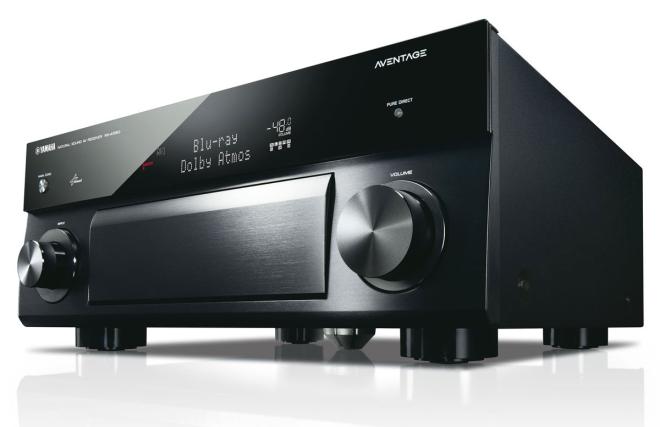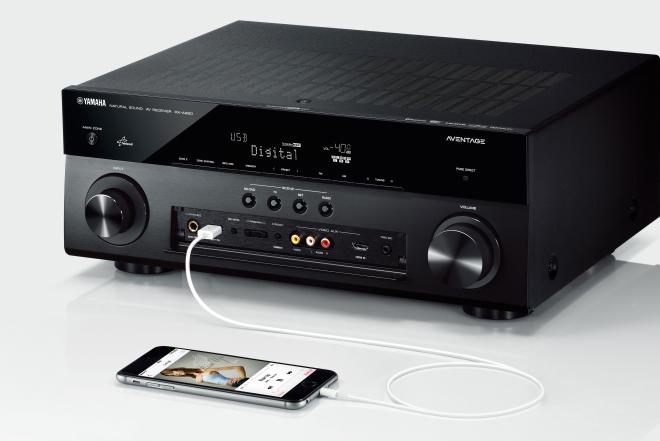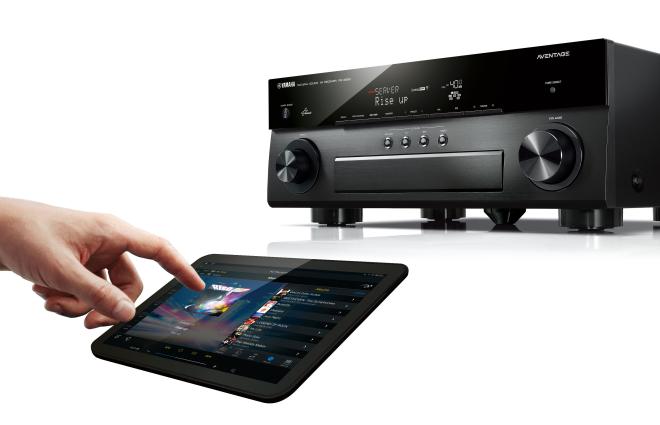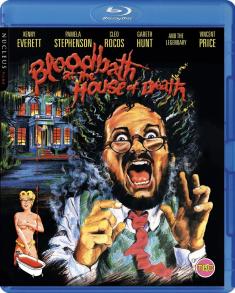Seven-Channel Hub: Yamaha AVENTAGE RX-A1050 AV Receiver
Overview -Pros
- Clean, powerful sound
- YPAO Room Correction
- Atmos & DTS:X (soon)
- 4K Ready HDCP 2.2 & HDMI 2.0a
- Dual Subwoofer Pre-Outs
Cons
- Pricing on the high end for only seven channels
- Front Display less focused on Dolby / DTS codecs
- A little deeper (in length) than some AV Receivers
- Firmware update notifications appeared only once
2015 has been an exciting year for home theatre technology, marking a significant dividing line between the future and past of AV Receivers. As Ultra HD Blu-ray debuts next year, more 4K displays hit stores for this Holiday season, and as object-based surround formats expand title availability, we are once again at a place where if you own last year's (or older) gear, you'll need to purchase a new AVR before jumping into any next-gen technology.
With this in mind, after reviewing an excellent flagship Onkyo AVR with all of last year's technology, I reached out to Yamaha to demo one of their new AVENTAGE AV Receivers in hopes of using one for my 'Ex Machina' DTS:X review. Alas, while the timing for that didn't exactly work out (we're still waiting on the DTS:X firmware update), I was able to do something I've never done before -- demo Dolby Atmos 5.1.2. My first home Atmos demo involved 5.1.4, after which I moved to 7.1.2 and 7.1.4. But, in all these months, I had never auditioned 5.1.2 because, after upgrading to 7.1 in the pre-Atmos era, I was reticent to take an aural step backwards. As this review will explain, I'm still a huge fan of 7.1.4, but 5.1.2 is pretty badass as EQ'd and powered by the A1050, and should prove a fine solution for those with spatial or budgetary restrictions.

Design & Specifications
At first glance, the Yamaha RX-A1050 seven-channel AV Receiver may look like every AVR you've ever owned -- it's a big, black box. But look a little closer and there's a certain refinement that reveals a higher end build quality. The 32.8 lb. body seems like it would be at home in a pro rack mount, while the polished black aluminum face is more rugged than plastic. The front display is bright and clear, revealing how many speakers (and which ones) are being amplified in addition to Surround Formatting, input, and volume levels. Around back, you'll find nine pairs of high quality speaker binding posts, seven HDCP 2.2 compliant HDMI 2.0a inputs as well as dual HDCP 2.2 HDMI 2.0a outputs, numerous other analog and digital inputs (coaxial, optical, stereo, phono), and pre-outs for 7.2 as well as a stereo Zone 2. Note, despite Dolby Atmos processing, there is no pre-out for height channel speakers for use with an external amp. The supplied silver/black remote feels light in the hand and ergonomic, but is otherwise plain and function-oriented. For much of my review, I used my trusty (but aging) Logitech Harmony One universal remote to control the majority of functions, but used the Yamaha remote to tinker with settings and various Surround Decode modes.
The only drawback I discovered is that the A1050, at 17.25" deep, takes up a little more shelf space than other AVRs, which make it a little more difficult to fit and/or adjust connections.
In terms of specs, the full AVENTAGE RX-A1050 list can be found HERE, or feel free to read the Owner's Manual, but let's check out a few highlights:
- 135W per channel @ 8ohms (Dynamic Power Per Channel)
- 8 HDMI 2.0a inputs (7 rear; 1 front)
- 2 HDMI 2.0a outputs (1 ARC, 1 Zone 2)
- 4K Ultra HD upscaling / passthrough with HDR support
- Dolby Atmos & DTS:X capable (DTS:X via a future firmware update)
- Dual Subwoofer Pre-Outs
- Cinema DSP 3D processing
- MusicCast enabled
- Bluetooth & Wi-FI
- AirPlay, Spotify, Pandora
- DLNA Certified
- AV Control App
- AV SETUP GUIDE App
- YPAO - R.S.C. (Reflected Sound Control) room calibration
- Multi-zone Audio Support
- USB Digital Connection for iPhone & iPad (front panel)
- ESS SABRE 9006A DAC with Compressed Music Enhancer
- DSD 2.8 MHz / 5.6 MHz, FLAC / WAV / AIFF 192 kHz / 24-bit, Apple® Lossless 96 kHz / 24-bit playback
- Symmetrical Amplifier Layout (isolates right and left channels)
- ECO Mode (lowers power consumption by 20%)
In other words, the Yamaha RX-A1050 has everything you'll need in an AVR for the next few years (save for an S-video input?). But, rather than serving solely as an AV processor/amplifier for movies, music, and television, it can also function as a whole home AV Hub, either by supplying audio and/or video to another location directly, or as part of a MusicCast system.

Set Up
Like any AVR, the first step is connecting speakers and AV sources. But, for the A1050, this step is also where you'll decide between all ear-level speakers or one that includes height channels. As mentioned above, there are nine pairs of speaker binding posts on the rear panel. Two are reserved for Surround Back speakers (as part of a 7.1 system), while another two are can be used as A) Front Presence (aka Height), B) a powered Zone 2, or C) as power to Bi-Amp your Front speakers. While most people won't need this flexibility, it saved me a lot of time, as I was able to toggle back and forth between 5.2.2 Dolby Atmos and more a traditional 7.2 configuration (I did not test Bi-Amping).
For speakers, I set aside my personal KEF iQ Series and brought in the absolutely stunning Klipsch Reference Premiere Series (full review soon). The 5.2.2 setup consisted of two RP-280FA floorstanders with built-in Dolby Atmos enabled speakers (for Front Right, Front Left, and the two Height Speakers), one RP-450CA center channel, dual 15" R115SW subs, and two RP-260F floorstanders serving as Surround Left and Surround Right. In the 7.2 setup, the A1050 disengaged the RP-280FA's Dolby Atmos speakers and, instead, powered two RP-250S "dual array monopole" speakers placed in the Surround Back Left and Surround Back Right positions (I'll explain in more detail in the forthcoming speaker review, but I find the RP-260F floorstanders shine more in the side surround placement rather than as rears).
After connecting several content sources via HDMI, I powered the A1050 and ran initial setup. There are two equally easy ways to configure and setup your Yamaha RX-A1050 -- follow along with on-screen prompts, or download the free AV SETUP GUIDE app (for Android or iOS devices). I stuck with the on-screen version. While it's not the cleanest, Yamaha recently updated its graphic user interface and the process is quick and simple, especially for home theatre enthusiasts. Wi-Fi connected, I updated the firmware (MusicCast was the big new feature for this initial update), then I went through a manual speaker calibration -- measuring distances, setting the crossovers, and using a level meter to even things out (I like to bump my height channels up 0.5 to 1.0dB to have them shine). Manual Calibration got me in the ballpark, but I couldn't quite get the subs (which are MASSIVE) to even out. So next I ran Yamaha's room-calibration software, YPAO. Ten to fifteen minutes later, the system was dialed in. Plenty of LFE if I needed it, and two different surround setups. But how does it perform?

A1050 in Real Life: 5.1.2 Dolby Atmos vs 7.1
The A1050 arrived at the perfect time for any gear demo -- just before the release of several excellent lossless surround mixes. 'Mad Mad: Fury Road' in Dolby Atmos redefined the 5-Star audio rating, while 'Bram Stoker's Dracula' mapped a path for studios to improve aging catalog titles, and 'San Andreas' nearly shook timbers from my ceiling. 'Furious 7' offered a chanced to compare a native 7.1 DTS-HD MA mix to 5.1.2 "Dolby Surround" (a Pro Logic-esque processed version of Atmos for 2.0, 5.1, and 7.1 content). And then there's Television; everything from 'American Horror Story: Hotel' to NFL Football to 'Empire!' to 'How to Get Away With Murder', I watched all sorts of 5.1 content in either Dolby Surround, or 7.1 via Pro Logic IIx. I'll get to my thoughts on the different configurations in a moment, but I must say that the A1050 did what all great AV Receivers do -- it became invisible. No noise. No excess heat. No distortion. It simply played movies and music in full glorious surround sound as loud as I wanted. With a Logitech Harmony One universal remote, all I ever had to do with the A1050 was bump the volume up or down to a comfortable level.
My only nitpick in this arena was setting the surround mode and how it appears on the AVR's display. Yamaha really wants you to use its Cinema DSP 3D technology, which first decodes a DTS or Dolby codec, and then processes the sound further -- not unlike adding in Dolby Surround or Pro Logic IIx. As such, instead of displaying an input codec such as DTS-HD MA or Dolby Atmos, the A1050 will simply say "Surround Decode," a mode where you can choose Cinema DSP, Dolby Surround, or Pro Logic IIx, among others. In this scenario, in order to ensure no processing was being applied, I had to use "Straight" or "Pure Direct" mode to ensure 7.1 tracks would not play in Dolby Surround. Most people won't really have this issue, as they won't hook up two different speaker configurations simultaneously, but I suppose I wish the A1050 would, more plainly and without having to bring up the GUI, display the current Audio Codec and whatever processing has been applied in a more clear fashion. Again, a nitpick.
Moving on. A lot of people have asked, "if I can only afford a seven channel AVR, do I go with 5.1.2 or 7.1?" Up until my time with the RX-A1050, I didn't really have a good answer. In my gut, I want everyone to get 7.1.4 because it offers a premium experience. But it also costs a lot more money to buy the extra speakers, processing, and amplification. And sometimes our rooms are small or oddly shaped. Sometimes we just don't have the budget. I get it.
So, dear reader, if you're in a place where the only two options are 5.1.2 or 7.1, pick 5.1.2. Hands down. If you follow this Dolby guideline for speaker placement, with the surround channels set behind your listening position at an angle, losing your Surround Back channels is a fair trade loss for what you get in added height immersion. It's just a better overall experience, whether you're dropping in 'Game of Thrones' (Season 1 or Season 2) in pure Atmos, or streaming 'Band of Brothers' via HBO GO, Dolby Atmos / Dolby Surround (and DTS:X / DTS: Neural X in the near future) have dramatically improved the sense of hemispherical sound. The only question left, then, is does one buy Atmos-enabled or in-ceiling speakers? Dolby Atmos enabled speakers work great if you can't cut into your ceiling, but sometimes feel a little front-heavy when there's only one pair. If you have a chance to, for 5.1.2, install in-ceiling speakers directly over your listening position, you're not only adding height sounds but also filling in whatever gap you might be creating by removing true side-surrounds. Either way, the debate (for me personally) is settled. 5.1.2 is a better experience. However, feel free to make any choice you'd like, this is just my opinion. If 7.1 ear level channels are a must-have for you, great. For this type of customer, I would recommend a more expensive AVR than can process and amplify nine to eleven channels for 7.1.2 or 7.1.4 configurations. The A2050 and A3050 are both capable of this.

Music, Wireless, & Network Features
After working the A1050 with all sorts of surround sound immersion, I then tested a few different music options, most of them wireless. Network streaming is established via Wi-Fi or an ethernet cable to your router. From there, you're a few button presses away from Pandora, Spotify (Premium subscription required), or Internet Radio. Bluetooth streaming from my laptop and iOS devices was simple, clear, and error free. I was particularly happy when I discovered the AVR would wake from sleep for Bluetooth, a feature not present in all AVRs. AirPlay works great with iOS devices too, providing an extended range for where you can take your on-network devices, but I prefer Bluetooth because it allows you to circumvent the iTunes universe. I don't have a Windows machine anymore, but the A1050 is DLNA certified as well, so it can access Windows as well as remote music servers with High Res audio files. Best of all, all of these can be controlled from a smartphone via the Yamaha AV Controller app (also great for making system tweaks).
All off the wireless features performed admirably, but my favorite thus far is MusicCast. If you're not aware of this new tech, we covered it HERE. Sadly, I wasn't able to take full advantage of the whole home system features just yet, but I as I said in my original article, the MusicCast app is clean, well designed, and easy to use. For my experiments, I mirrored sound from my living room to a remote Bluetooth speaker outside. Perfect for grilling on game day as well as for traditional music listening. And even with this limited experiment, I can only imagine how great it will be to add on more MusicCast capable devices.
I also used the A1050 Zone 2 capability to listen to music using only the Klipsch RP-280FA Dolby Atmos enabled speakers. Some AVRs require a master's degree to figure out Zone 2 functionality; the A1050 requires only a simple amp selection, and one button pressed on the remote. (Have I mentioned this AVR is easy to use?) Zone 2 works as promised and, using stereo music, I was able to demonstrate that the RP-280FA's up-firing speakers might just be the best Dolby Atmos enabled speakers on the market. It literally sounded like, directionally speaking, my in-ceiling speakers were in use. Wow.
Lastly, I want to talk about Firmware Updates. A must in the modern world where electronics can be improved sans expensive repairs. While some AVRs are a little too persistent with firmware update notifications, I found Yamaha's approach to be the opposite. That is, if you don't accept the update upon the initial notification, it never asks again (until I manually upgraded the firmware and a different update later presented itself). I wish there was more of a middle ground here, perhaps a weekly reminder. Either way, a pretty minor complaint.
DTS:X & Neural X
I reached out to Yamaha earlier this year because it was one of the first AV Receiver manufacturers to release a 2015 AVR with DTS:X capability. Alas, despite an expended loaner period with the RX-A1050, the DTS:X firmware update did not arrive so, despite owning 'Ex Machina', I have yet to test this format out in the home. I have another brand new 2015 AVR in-house now, the Denon AVR-X6200W, so hopefully the DTS:X firmware for that model will arrive shortly. I'm very much looking forward to seeing how X and Neural X perform.
Also, some 2015 AVR purchasers have noted that, on brands like Denon, Dolby Surround (aka the Dolby Surround Upmixer) only processes Dolby codecs; IE, if you toss a DTS-HD MA sound mix at the AVR, Dolby Surround is NOT an option. Particularly annoying when Neural X in not out yet. However, Yamaha can sleep easy knowing no such division exists in this model line (as of this writing, pre DTS:X firmware update). The A1050's Dolby Surround up-mixed all Dolby and DTS codecs as well as LPCM tracks.

Final Thoughts
The Yamaha AVENTAGE RX-A1050 is an elegant, high performance, next generation AV Receiver with all the bells and whistles you'll need for the next few years as 4K devices and content become more mainstream. No matter what type of material I threw at it, no matter how loudly I asked it to play, the RX-A1050 delivered clear, accurate, distortion-free sound. Given this performance and build quality, it's no surprise Yamaha is the number one AV Receiver manufacturer in the world.
My only reservation with this particular model -- aside from some small, likely personal, nitpicks -- are the number of amplified channels. Dolby Atmos 5.1.2 is quite effective for small-to-medium-sized listening environments (more than I would have assumed prior to this review), but at an over-$1,000 price point, we're in range of nine-channel amps (for 7.1.2 or 5.1.4), which might represent a better value and more immersive surround sound. Then again, while I'm looking forward to returning to the fuller immersion of 7.1.4, I understand it's not for everyone's budget or space.
If you're in the market for 5.1.2 or 7.1 and need a flexible AVR that can handle 4K content, power an external zone, and/or act as the hub of a whole home wireless music system (via MusicCast), the Yamaha RX-A1050 comes Highly Recommended. For those who need more processing power, yet want similar features and MusicCast, check out the other 2015 AVENTAGE models, the RX-A2050 (nine channels of power & processing) or RX-A3050 (nine channels of power & 11 channels processing).












